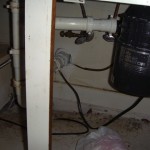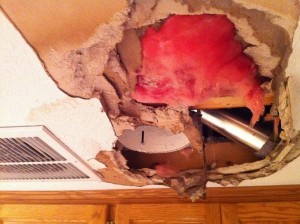Prevent Water Damage From Broken Water Pipes
Water damage or basement flooding can come from a variety of sources. There could be bad weather conditions or there could be a leaky or broken pipeline. Even a cracked foundation will result in water damage. If it was something as simple as a faucet, you can do it your self. But, it can get more complicated when a hidden pipeline is broken.
Frozen, Broken Water Pipes Can Be Home Owner Nightmare
Water is capable of causing extensive damage to your home property with damage to floors, ceilings, walls, rugs, furniture and other personal property. A slight 1/8-inch crack in a water pipe can release and amazing 250 gallons of water per day.
Broken Water Pipes
First identify the extent of the water damage by inspecting the area for stains and softness. You also want to pinpoint the source of the problem.
Pipe breaks are a leading cause of flood damage. In most cases, pipes break during freezing weather. In fact, frozen and broken water pipes rank No. 2 behind hurricanes in terms of both the number of homes damaged and the amount of claim costs in the U.S. As temperatures fall, water expands and causes localized pressure. When the pressure becomes too great, a break occurs. This may create a pinhole leak, hairline break or large crack.
Find That Leaking Pipe!
The dripping water may be coming from quite a distance away and is certainly an indication of a much greater problem.
If you know there is water leaking, but you cannot find the source yourself, then you should get professional help right away. These types of problems only get worse the longer they are left untreated.
- Pinhole leak in ceiling water pipe in the basement
- Removed wet sheet rock and insulation
If the insulation is wet, remove it and dispose of properly. After being wet, most insulation is ineffective, but it will continue to hold moisture for a long time and will create high moisture conditions which will damage metal, masonry, and wood.
Materials in your home that get wet from leaks, like sheet rock, wood and carpet, can not only result in expensive repairs but pose a serious health threat from mold and mildew.
Do not attempt to dry sheetrock. It is impossible to completely remove mold from porous surfaces such as paper, Sheetrock (drywall) and carpet padding, so these materials should be removed and discarded. Usually, attempts to dry sheetrock after a flood have been a waste of time and effort because it is labor intensive to dry interior walls and it is not possible to dry interior walls with insulation or multiple layered sheetrock.
Mold resistant sheetrock may be specified when installing replacement sheetrock.
• Disinfected and dried structure
Drywall Water Damage
If you have a sheetrock (drywall) water damage repair job due to a leaky or broken pipe, a flood or other cause you need to give it immediate attention. If mold gets in or behind drywall, it’s a serious matter. Where there has been water damage, black mold may appear, but mold can also grow in areas that are hidden. It’s common for fungus to spread to nearby areas, such as surrounding walls, floors, carpets and ceilings.
The big concerns with drywall water damage repair, is being absolutely certain that you are not overlooking the true extent of the damage. Sagging or wet drywall is easy to identify and cut away. But there may be greater structural damage or moisture left in the surrounding area. Even if you plan to do the bulk of the cleanup yourself, you may sill wish to call a water damage expert to ensure that the structural integrity of the walls has not been jeopardized and that there is no mold that has formed or will form. While nobody likes to be told that a repair job is more expensive or bigger than they had first thought, if you don’t fix it completely now, it could turn into an even greater and costlier problem some time in the future.
Note: Bleach won’t do the job. Mold cannot be eliminated simply by pouring bleach on it or scrubbing an affected area with bleach. Most chemicals are ineffective against spores, and the mold will have a tendency to return.
In this case your best bet would be to shut off the entire water supply to your home. Once you are sure that the water supply is stopped up, call a Minnesota water damage repair company. Unless the damage is very small, it would be inadvisable for you to do the water damage clean up on your own for the reasons below.
- Depending on the water source, your damage restoration will require water extraction and drying. For decontamination, various EPA approved chemicals will need to be used. This might be hard to do on your own because with all the different equipment and different cleaning agents.
- You may also lack the knowledge about things that are associated with the water damage cleanup process. For example, you might not know how many dehumidifiers will be required to dry out a certain space or you might not know how fast the water will need to be pumped out of a space. A really quick extraction of water from a room flooded with a lot of water might result in caving in the room walls which is something you don’t want to happen.
- You might not have the needed equipment when it comes to carrying out a large water cleaning. A professional from a water restoration company will have more than a few commercial grade or heavy duty pieces of equipment such as fans, dehumidifiers and desiccants. They will also have water extraction units; damp meters and other tools that will help them perform the damage cleanup in an efficient manner.
- Water damage restoration companies will often look at the larger picture in the house or business to see what caused the damage in the first place. If they see any potential problem areas on your property, they will let you know about it and will help you to avoid the problem in the future.
Inspect Your Home
Inspect your home and make sure you know which areas have poor heating. Check plumbing fixtures such as valves and hoses regularly and perform routine maintenance work to ensure they are always in good condition.
When Outside Temperature Drops
 When winter kicks in, you should maintain the temperature in your basement above 55 degrees. If the pipes under your kitchen sink are not insulated, open the cabinet doors to let warm air in. Look for leaks around your home that allow cold air to enter inside close to where the pipes are. Seal these leaks by caulking or insulating the area. This is important because, in severe cold weather, outside air can be cold enough to cause pipes to freeze even when it is entering the house through a tiny opening.
When winter kicks in, you should maintain the temperature in your basement above 55 degrees. If the pipes under your kitchen sink are not insulated, open the cabinet doors to let warm air in. Look for leaks around your home that allow cold air to enter inside close to where the pipes are. Seal these leaks by caulking or insulating the area. This is important because, in severe cold weather, outside air can be cold enough to cause pipes to freeze even when it is entering the house through a tiny opening.
Before You Go
If you will be traveling and leaving your home vacant, do not switch off the heating system but instead set it on low and to activate twice a day. Most modern units will have this automatic power-on setting. If you will be away for quite some time, ask a reliable relative or friend to check up on your home to ensure the temperature inside stays at or above 55 degrees.
Before a Frozen Pipe Bursts
While pipes can leak, break, crack or burst simply from age and normal use over time, one of the most common causes of domestic water damage in the winter is frozen pipes. You should treat frozen water supply pipes as an urgent matter because it can cause your pipes to burst and water to come spewing from the cracks the moment the ice thaws. To prevent frozen pipes from bursting, follow the tips below as soon as you discover the problem:
- Turn off the main water supply valve, including the valve in your cold water tank, if you have one. Leave water taps turned on.
- Prevent possible water damage by protecting the structures and objects that could be affected if the frozen pipe bursts. For example, remove the carpet in the room or take furniture or other belongings to a safe room.
- Thaw out the frozen pipe by opening the tap closest to it so that the water can be released through when the ice has melted. You can also use a hot water bottle or a blow-dryer to thaw a frozen pipe, starting at the pipe closest to the faucet and moving towards the coldest part. Just be careful when using the hairdryer and never use it in standing water. Likewise, do not use any device with an open flame such as a blow torch for this task.
When burst pipes do happen, a professional restoration company is your best bet to keep damages to a minimum. A professional water damage restoration contractor will select the structural drying equipment in a scientific method based on materials, size of the water damage area, and the class and category of the water damage.


